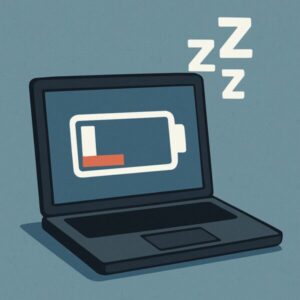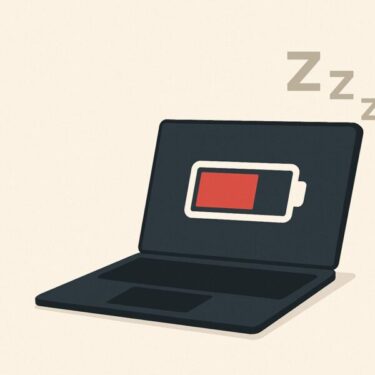Have you ever closed your laptop lid, thinking it was asleep, only to wake up and find the battery nearly dead?
You’re not alone.
On many modern laptops, the screen turns off but parts of the system keep running in the background. Features like Modern Standby (S0), network connectivity during sleep, and wake timers can drain the battery even when the lid is closed.
This guide explains why it happens and gives you practical fixes—from quick checks to advanced tweaks—so your laptop actually sips power while asleep.

Common Causes and How to Fix Them
1. Modern Standby (S0) keeps the PC semi-active
With S0, Windows can sync mail, keep Wi-Fi alive, and let apps run briefly while the screen is off—great for instant-on, not for battery life.
Check supported sleep states
- Right-click Start → Windows Terminal (Admin)
- Run:
powercfg /a
Interpret
- Standby (S0 Low Power Idle) listed → Modern Standby is available (potential drain).
- Standby (S3) listed → Traditional deep sleep (usually better battery life).
- If S3 is not available, some BIOS/UEFI offer a toggle between S0/S3 (names vary: “Modern Standby”, “Legacy Sleep”, “S3 only”).
Action (if offered by your device): In BIOS/UEFI, prefer S3 over S0. Otherwise, reduce S0 background activity with the controls below.
2. USB devices still draw power during sleep
- Device Manager → expand Universal Serial Bus controllers/Keyboards/Mice → each device → Power Management tab → check Allow the computer to turn off this device to save power.
- If your BIOS has USB charging while off/asleep, set it to Disabled (prevents trickle drain).
3. Wi-Fi/Bluetooth remains active in standby
Windows 11 lets you choose whether to keep the network alive while sleeping.
- Settings → System → Power & battery → Power (or Additional power settings) → look for Network connectivity in Standby and set it to Never (or Only when plugged in).
- Optionally, in Device Manager → your Wi-Fi/Bluetooth adapter → Power Management → uncheck Allow this device to wake the computer.
4. Fast Startup prevents a clean power-down
- Control Panel → Power Options → Choose what the power buttons do → Change settings that are currently unavailable → uncheck Turn on fast startup.
5. Lid close action is set to “Do nothing”
Closing the lid may not actually sleep the PC.
- Control Panel → Power Options → Choose what closing the lid does → set On battery to Sleep (or Hibernate for zero drain).
🔬 Bonus: See what’s using battery in sleep
- Generate a battery report:
powercfg /batteryreport(open the saved HTML report). - Deep dive (Modern Standby):
powercfg /sleepstudy(shows which components/apps are active during S0).
Advanced Battery-Saving Tips
1. Disable wake timers
- Control Panel → Power Options → Edit plan settings → Change advanced power settings → Sleep → Allow wake timers → set Disabled for On battery and Plugged in.
2. Find what woke the PC last
- Run:
powercfg /lastwake(see the device or reason). - List devices allowed to wake:
powercfg /devicequery wake_armed, then open that device’s Properties → Power Management and uncheck wake permissions if needed.
3. Disable Wake on LAN if you don’t need it
- Device Manager → Network adapters → (your adapter) → Properties → Power Management → uncheck Allow this device to wake the computer.
4. Limit Windows Update activity during off hours
- Settings → Windows Update → set Active hours correctly and review Advanced options so the device doesn’t wake or reboot overnight.
5. Reduce background activity
- Settings → Privacy & security → Background apps → turn off apps you don’t need (mail, cloud sync, etc.).
- Consider setting Hibernate after (e.g., 30–60 minutes) under Advanced power settings for a guaranteed low-drain state.
These tweaks can turn a 30–50% overnight drain into just a few percent.
❓ Frequently Asked Questions (FAQ)
Q. Should I use Hibernation instead of Sleep?
A. For the best battery life: Yes. Hibernation writes memory to disk and powers off—near-zero drain—while restoring your session on power-up.
Q. This started after a Windows update—why?
A. Updates can reset power/network settings or add new capabilities (e.g., keeping network connectivity in standby). Revisit the settings above after major updates.
🧭 Final Thoughts
Sleep behavior depends on both hardware and Windows settings. If your battery drains overnight, the laptop probably isn’t truly sleeping. Confirm which sleep states you have, see what’s waking the device, and turn off background connectivity. A few targeted changes usually fix the problem.
Summary Table
| Cause | Recommended Fix |
|---|---|
| Modern Standby (S0) activity | Prefer S3 in BIOS if available, or restrict network/background during S0 |
| USB devices drawing power | Allow Windows to turn off USB devices; disable USB charging in BIOS |
| Network stays on in sleep | Set “Network connectivity in Standby” to Never |
| Fast Startup enabled | Turn off Fast Startup in Power Options |
| Lid does nothing | Set “When I close the lid” to Sleep or Hibernate |
| Unknown wake events | Use powercfg /lastwake and remove wake permissions |
Apply the fixes that match your setup and enjoy longer battery life—even with the lid closed.
You Might Also Like
▶︎ Can’t Connect via RDP with Your Microsoft Account? Here’s Why—and How to Fix It (Windows 10)
▶︎ Fixing Windows 11 Update KB5058411: Common Errors and Solutions
▶︎ 🔧 Common Windows Error Codes and How to Fix Them


